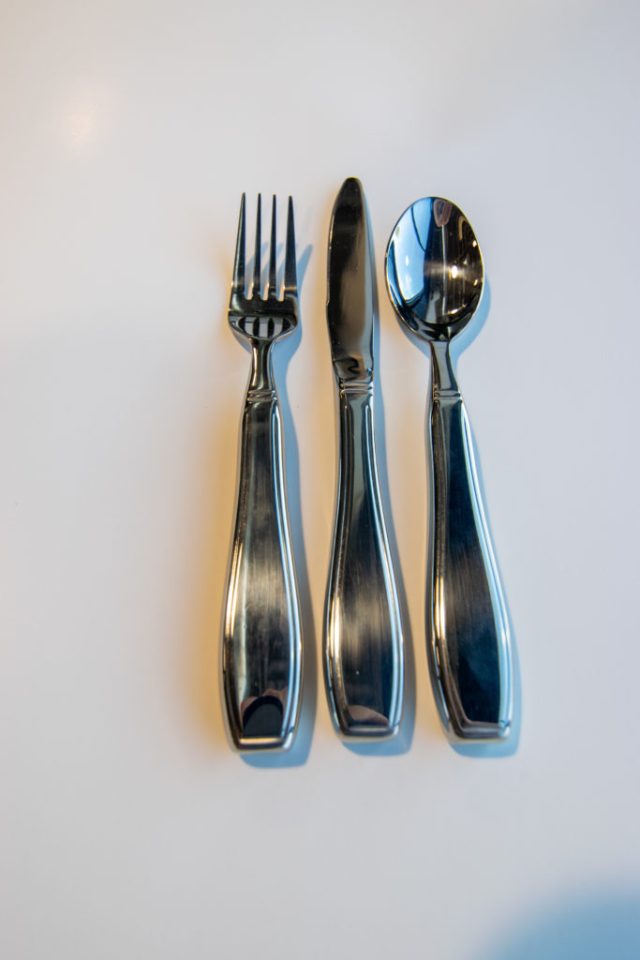

Some of us are blessed with manual dexterity, but others, not so much. I’ve known people whose hands are so steady they could do brain surgery, but personally I have difficulty removing a splinter, and this puts me at a disadvantage in the maker universe.
Ever since I was a kid, I’ve had a mild case of “essential tremor.” This is a relatively common neurological condition in which the brain over-corrects in response to feedback from the fingers, somewhat like a closed-loop servo system doing “hunting” oscillations. Unlike Parkinson’s disease (which has serious consequences), essential tremor is harmless. It just annoys me when I can’t apply the tip of a soldering iron precisely where it is supposed to go.
Recently I discovered that there are simple ways to deal with this problem, and the strategies and gadgets may be helpful for detail work, even if you don’t have especially shaky hands.
ADDING RESISTANCE

The simplest option is to add mass to the tool that you’re using, because mass has inertia, and inertia provides resistance to motion. Suppose you are lifting a dumbbell. The weight is so heavy, it will subdue any tremor in your hand. At the other extreme, if you’re holding disposable wooden chopsticks that weigh a couple of grams, you may have difficulty picking up grains of rice. Even a normal steel fork is easier to use than chopsticks — and in fact people with significant tremors can buy weighted knives, forks, and spoons to improve their coordination.
Other options also exist:

• If your handwriting is shaky, you can try a weighted pen holder.

• The all-purpose weighted handle above

I might be able to address my soldering-iron problem by wrapping something heavy around the handle, such as 3M weighted tape, which is sold for balancing automobile wheels. This is expensive, though, and there’s a more general solution which works with almost any small hand tool. The above image shows a double-walled cloth pad filled with steel shot, which attaches to the back of your hand using a velcro wrist strap and elastic loops that fit over your fingers.
This Hand Weight (the term is trademarked) was invented by Mary Ann Heinz, an occupational therapist who started a business named Handithings 22 years ago. Her son Brian now owns the company, and I was so intrigued by the product, I contacted him in Moscow Mills, Missouri, for a quick Zoom interview.
“Initially my mother worked with special-needs children who had difficulty using their hands,” he explained. “But we found that sales of larger sizes of Hand Weights were going through the roof, and I started getting feedback from hand surgeons that people were using them for Parkinson’s and essential tremors. It’s now our number-one product.”
Handithings has provoked competition from medical equipment manufacturers, but Brian says he’s happy to remain a family business whose products are made locally. “The people who sew them for us are five minutes from here,” he says.
“I decided to buy a couple of Hand Weights, and they actually do make my hands steadier. They also have a beneficial psychological effect, because I don’t get so frustrated as a result of struggling with my poor coordination.”
SOFT TIPS

My experience prompted me to revise many of my habits relating to detail work. When trying to grab a diode or a 3mm LED, I don’t fumble around with my finger and thumb anymore. I use very sharp-tipped pliers such as those in Figure E


In the past, I avoided tweezers because the tips were too thin — but when I searched online, I found tweezers with chiseled tips, shown in Figure F

This gave me the idea of adding compliant material around the jaws of regular long-nosed pliers. I bought 1/8″ internal-diameter latex tube from McMaster-Carr, and mounted a couple of pieces on pliers as in Figure 
GOING FURTHER
To achieve total hand stability, I can imagine a device mounted on the back of each hand using accelerometers to sense small motions and a haptic output that generates negative feedback. This would be just the thing for people who have difficulty pulling out splinters — and maybe even for brain surgeons,
[+] Universal Access
Makers, with their broad knowledge and range of skills, have been producing accessible devices for many years. Here are a few individuals and groups that are helping let everyone participate in all types of activities. —Caleb Kraft
- AbleGamers — ablegamers.org
- SpecialEffect — specialeffect.org.uk
- Makers Making Change — makersmakingchange.com
- Warfighter Engaged — warfighterengaged.org
- Tikkun Olam Makers — tomglobal.org/about
- e-Nable — enablingthefuture.org
- The Controller Project — thecontrollerproject.com
- Ben Heck — benheck.com
ADVERTISEMENT
Join Make: Community Today








